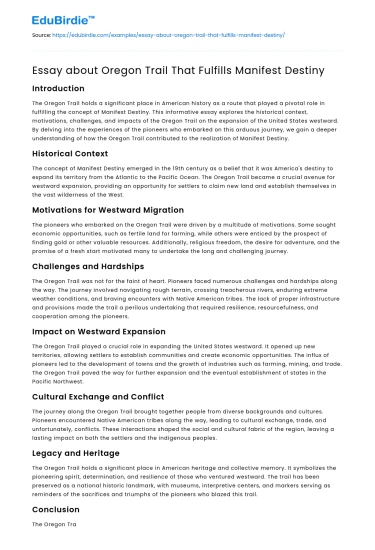Introduction
The Oregon Trail holds a significant place in American history as a route that played a pivotal role in fulfilling the concept of Manifest Destiny. This informative essay explores the historical context, motivations, challenges, and impacts of the Oregon Trail on the expansion of the United States westward. By delving into the experiences of the pioneers who embarked on this arduous journey, we gain a deeper understanding of how the Oregon Trail contributed to the realization of Manifest Destiny.
Historical Context
The concept of Manifest Destiny emerged in the 19th century as a belief that it was America's destiny to expand its territory from the Atlantic to the Pacific Ocean. The Oregon Trail became a crucial avenue for westward expansion, providing an opportunity for settlers to claim new land and establish themselves in the vast wilderness of the West.
Save your time!
We can take care of your essay
- Proper editing and formatting
- Free revision, title page, and bibliography
- Flexible prices and money-back guarantee
Motivations for Westward Migration
The pioneers who embarked on the Oregon Trail were driven by a multitude of motivations. Some sought economic opportunities, such as fertile land for farming, while others were enticed by the prospect of finding gold or other valuable resources. Additionally, religious freedom, the desire for adventure, and the promise of a fresh start motivated many to undertake the long and challenging journey.
Challenges and Hardships
The Oregon Trail was not for the faint of heart. Pioneers faced numerous challenges and hardships along the way. The journey involved navigating rough terrain, crossing treacherous rivers, enduring extreme weather conditions, and braving encounters with Native American tribes. The lack of proper infrastructure and provisions made the trail a perilous undertaking that required resilience, resourcefulness, and cooperation among the pioneers.
Impact on Westward Expansion
The Oregon Trail played a crucial role in expanding the United States westward. It opened up new territories, allowing settlers to establish communities and create economic opportunities. The influx of pioneers led to the development of towns and the growth of industries such as farming, mining, and trade. The Oregon Trail paved the way for further expansion and the eventual establishment of states in the Pacific Northwest.
Cultural Exchange and Conflict
The journey along the Oregon Trail brought together people from diverse backgrounds and cultures. Pioneers encountered Native American tribes along the way, leading to cultural exchange, trade, and unfortunately, conflicts. These interactions shaped the social and cultural fabric of the region, leaving a lasting impact on both the settlers and the indigenous peoples.
Legacy and Heritage
The Oregon Trail holds a significant place in American heritage and collective memory. It symbolizes the pioneering spirit, determination, and resilience of those who ventured westward. The trail has been preserved as a national historic landmark, with museums, interpretive centers, and markers serving as reminders of the sacrifices and triumphs of the pioneers who blazed this trail.
Conclusion
The Oregon Trail stands as a testament to the vision of Manifest Destiny and the determination of the American people to expand westward. It provided a pathway for pioneers to fulfill their dreams of land ownership, economic prosperity, and a fresh start in the untamed wilderness. The challenges and sacrifices faced by these pioneers are a testament to their resilience and the indomitable spirit that shaped the nation. The legacy of the Oregon Trail continues to resonate today, reminding us of the profound impact of westward expansion and the enduring legacy of Manifest Destiny in shaping the United States.






 Stuck on your essay?
Stuck on your essay?

